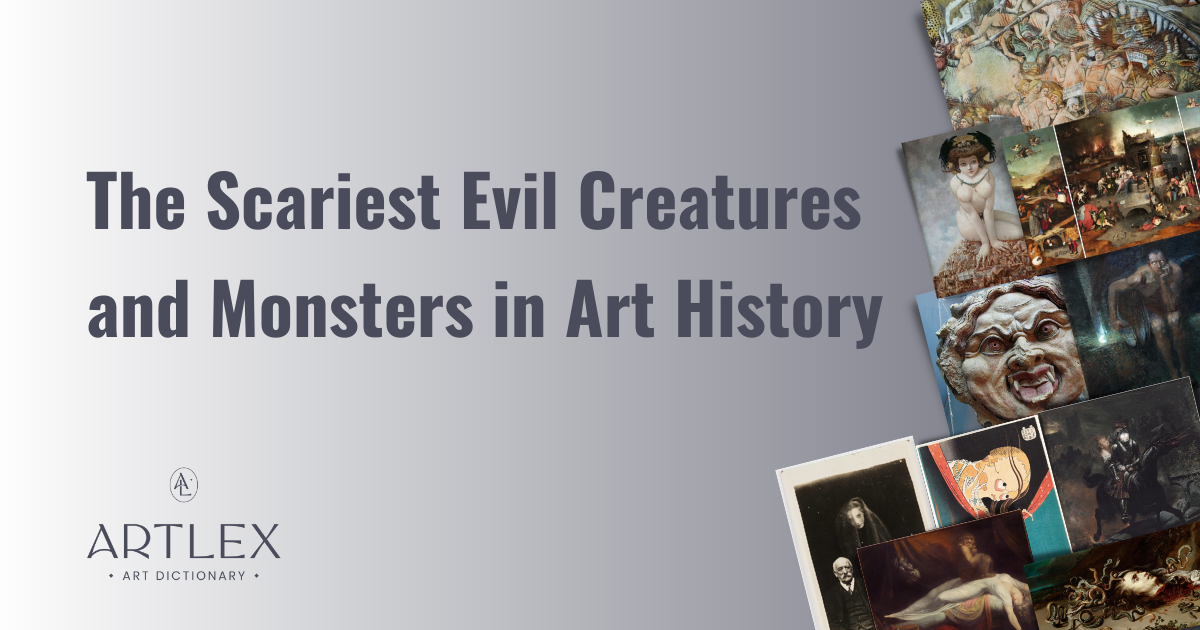
The 10 Scariest Evil Creatures and Monsters in Art History
Throughout the centuries, monsters and malevolent creatures have populated countless artworks. This fascination came from a need to express human fears but was also a way to depict men’s vices. What’s more, monsters and creatures offered artists the opportunity to let their imagination run wild. For centuries, artists followed established rules and mainly depicted religious or mythological scenes. Painting or sculpting landscapes packed with nightmarish monsters allowed them to explore their creativity fully.
- Historical Role of Monsters in Art: Monsters in art historically expressed human fears, depicted vices, and allowed artists to explore creative freedom, often beyond the confines of religious or mythological traditions.
Entities: Monsters, artists, artworks.
Attributes: Creativity, fear, vice depiction. - “Scene of the Passion of Christ” by Giovanni Canavesio (15th century): The fresco in La Brigue, France, depicts the Leviathan swallowing the damned on Judgment Day, reflecting medieval fears of death during a time of famines, wars, and pandemics.
Entities: Giovanni Canavesio, Leviathan.
Attributes: Judgment Day, death, religious fears. - Etruscan Gorgoneion (5th century BCE): Found in the ruins of an Etruscan temple, this depiction of Medusa’s head symbolized protection and fright, rooted in Greek mythology’s fear of the Gorgons.
Entities: Gorgons, Medusa.
Attributes: Mythology, fear, protection. - “The Head of Medusa” by Peter Paul Rubens (1617-18): Rubens painted a lifelike Medusa with greenish skin and a bleeding head surrounded by snakes, symbolizing the enemy’s evil thoughts and shifting Medusa’s role from protector to symbolic representation of malice.
Entities: Peter Paul Rubens, Medusa.
Attributes: Evil, symbolism, Baroque art. - “The Temptations of St. Anthony” by Hieronymus Bosch (ca. 1500): Bosch’s triptych in Lisbon portrays St. Anthony’s struggle against demonic temptations in a surreal landscape filled with hellish monsters, representing humanity’s battle between good and evil.
Entities: Hieronymus Bosch, St. Anthony.
Attributes: Temptation, surrealism, seven deadly sins. - “The Ghost of Kohada Koheiji” by Katsushika Hokusai (1833): Part of the Edo period’s ghost tale series, this Japanese print depicts a vengeful ghost from folklore who kills his unfaithful wife and her lover, emphasizing the supernatural storytelling tradition.
Entities: Katsushika Hokusai, Kohada Koheiji.
Attributes: Ghost stories, Edo period, vengeance. - “She” by Gustav-Adolf Mossa (1905): Symbolist painter Mossa portrays a femme fatale standing on a pile of miniaturized bodies, symbolizing the decadence of the Belle Époque and the destructive power of venal women.
Entities: Gustav-Adolf Mossa.
Attributes: Symbolism, decadence, femme fatale. - “The Nightmare” by Henry Fuseli (1781): Fuseli’s iconic painting depicts sleep paralysis through demonic imagery, including a creature on a woman’s chest and a spectral horse, exploring subconscious fears.
Entities: Henry Fuseli.
Attributes: Sleep paralysis, subconscious fear, Romanticism. - Spirit Photography by William Hope (ca. 1920): Hope’s double-exposure photography combined the growing popularity of spiritualism and photography, creating ghostly images that exploited grief and the fascination with death.
Entities: William Hope.
Attributes: Spirit photography, spiritualism, double exposure. - “Lucifer” by Franz von Stuck (1891): This dark portrayal of Lucifer as a fallen angel with piercing eyes captures the tension between light-bringer mythology and his later association with evil in Christian tradition.
Entities: Franz von Stuck, Lucifer.
Attributes: Fallen angel, Christian mythology, evil. - “The Ballad of Lenore” by Horace Vernet (1839): Inspired by the Gothic ballad, Vernet’s painting illustrates Lenore’s tragic ride to the grave with Death disguised as her lover, symbolizing the inevitability of death.
Entities: Horace Vernet, Lenore.
Attributes: Death, Gothic ballad, Romanticism.
1. Scene of the Passion of Christ, by Giovanni Canavesio, 15th century
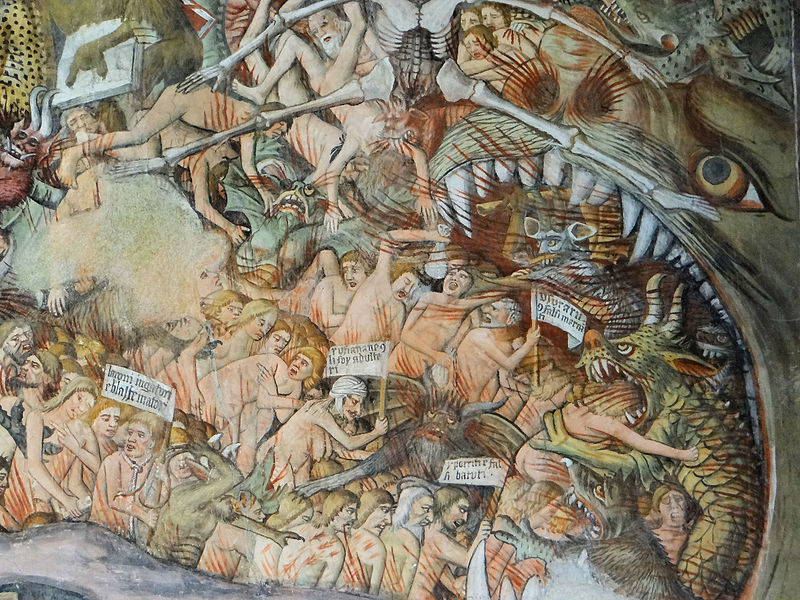
This scary scene, filled with monsters and vile creatures, is part of the frescoes painted on the walls of the chapel Our Lady of the Fountains in La Brigue, Southwestern France, near the Italian border. Between 1490 and 1492, Italian priest and painter Giovanni Canavesio depicted the grandiose religious scenes spreading on the inside walls of this rather plain-looking chapel.
Besides other scenes of the Passion of Christ, Canavesio depicted the Leviathan, a dragon swallowing the damned on Judgment Day. At a time when famines, pandemics, and wars killed unexpectedly, people feared and, at the same time, were fascinated by death. Artists produced impressive representations of raging infernos or dance scenes mixing skeletons and humans, expressing men’s anguish and fears.
2. Etruscan Gorgoneion, 5th century BCE
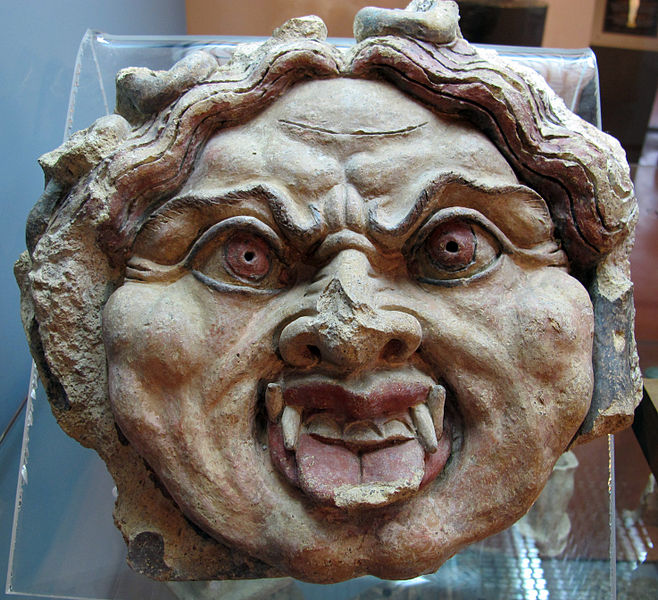
The Gorgoneion is the name given to the representation of a Gorgon’s head, often found in ancient Greek and Roman architecture, shields, coins, ceramics, or other kinds of objects. In Greek mythology, gorgons were three sisters, Euryale, Stheno, and the most feared of all, Medusa. With their wings, claws, sharp teeth, and a head covered with snakes, gorgons could turn into stone their enemy with a simple gaze.
Perseus, the mythological hero, was able to cut Medusa’s head off by looking through a mirror to avoid the gorgon’s petrifying gaze. The winged horse Pegasus was born from the blood running down her neck and dripping into the ocean.
Inspired by the myth, artists often portrayed Medusa’s head on architectural elements or objects. By doing so, they believed it gained the power to frighten their enemy or protect them against evil forces. This fragment of Medusa was found in the ruins of the Etruscan Temple of Belvedere in Orvieto, Italy.
3. The Head of Medusa, by Peter Paul Rubens, 1617-18
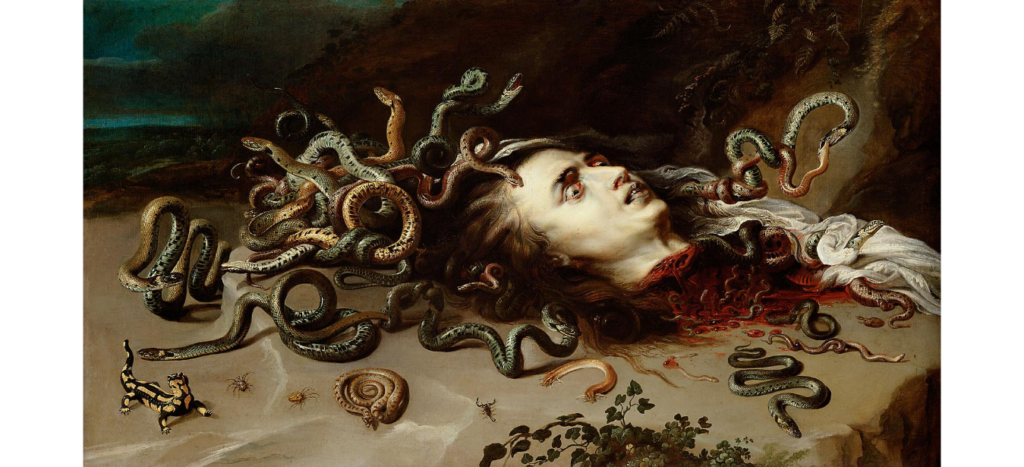
Flemish Baroque painter Peter Paul Rubens also made a dreadful portrait of Medusa. The painter excelled in the depiction of complexions. In The Head of Medusa, he used his skills to render the dead gorgon’s greenish skin. The chiaroscuro effect adds to the dramatization of the scene. Frans Snyders, a Flemish artist specializing in animal painting, may have painted the snakes and insects surrounding Medusa.
Rubens’ Medusa impressed his contemporaries, inspiring fellow artists to depict the evil gorgon. The depiction of Medusa lost its protecting power and gained a more symbolic meaning instead. The snakes stand for the enemy’s evil thoughts in Rubens’ painting, escaping its bleeding head.
4. The Temptations of St. Anthony, by Hieronymus Bosch, ca. 1500
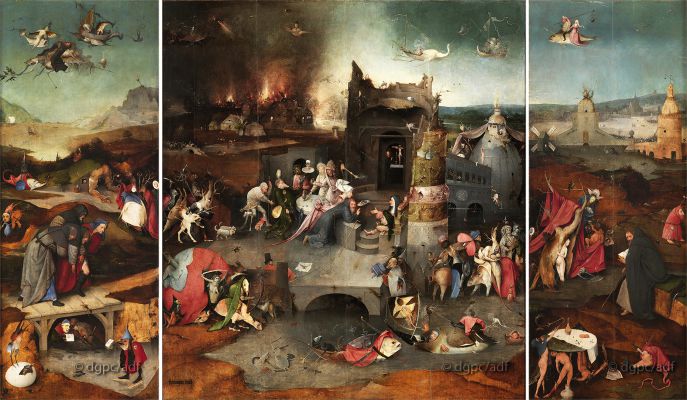
Anthony the Great was a Christian monk living as a hermit in the Egyptian desert at the end of the 3rd century. During his years in the desert, the Devil himself and his evil monsters tempted Anthony and tried to seduce him.
The temptations of St. Anthony has been a subject of choice for artists to showcase their inventive talent. Since the Middle Ages and up to the 20th century, numerous representations of the subject have been made. This setting allowed artists to represent hellish scenes filled with hair-raising creatures.
Hieronymus Bosch, the Netherlandish painter who mastered the depiction of Hell, painted about 15 scenes illustrating the temptations of St. Anthony. In this triptych exhibited at the National Museum of Ancient Art in Lisbon, Portugal, St. Anthony stands alone amid malicious monsters. Bosch depicted the struggle between Good and Evil, with the personified seven deadly sins.
5. The Ghost of Kohada Koheiji, by Katsushika Hokusai, 1833 (Edo Period)
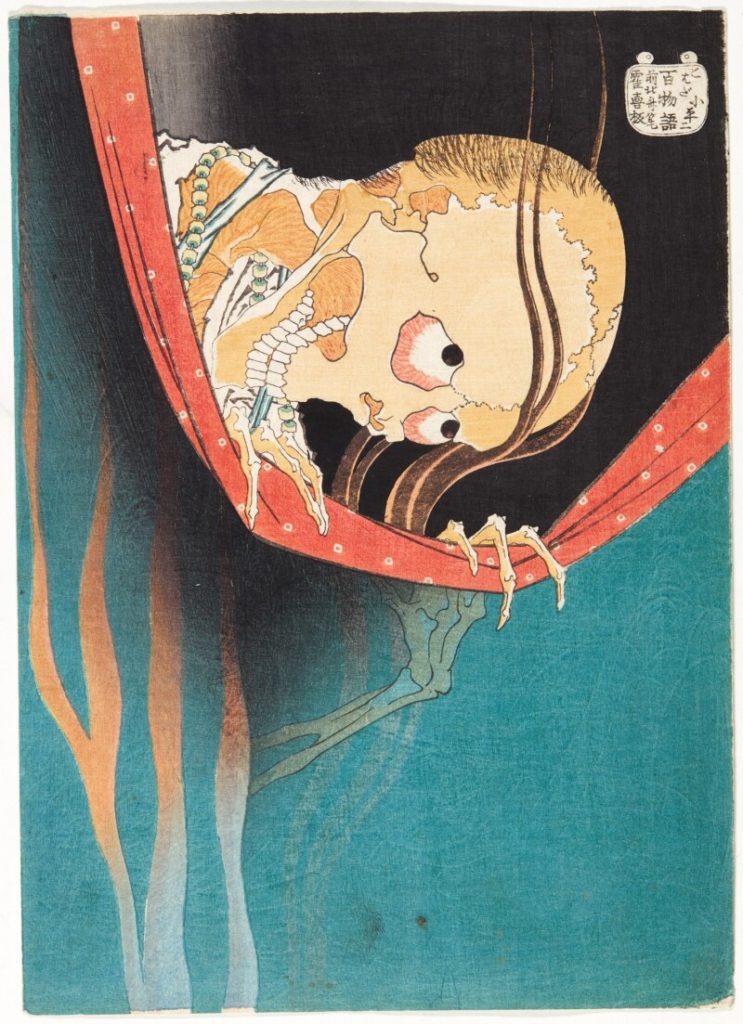
This print by the Japanese Katsushika Hokusai is part of the One Hundred Ghost Tales series. During the Edo period (1603-1867), ghost stories were very popular. Usually, they were told at night while playing a game known as Hyakumonogatari Kaidankai. In a room lit by a hundred oil lamps, each player told a story to the assembly about a supernatural encounter they experienced. After each story, the teller had to blow out a lamp until all of them were extinguished, and the room turned pitch-black. Then, spirits would supposedly come out in the dark room.
The illustrious painter and printmaker Hokusai may have intended to produce a hundred prints on this theme. Yet, only five are known today. Each of them pictures a Yōkai, a kind of spirit in Japanese folklore.
According to the legend, Kohada Koheiji, an actor of the Edo period, was killed by his wife and her lover. In this print, his ghost comes back to haunt the murderous illegitimate couple. In an uncontrolled fury, the ghost killed his wife and her lover before killing himself.
6. She, by Gustav-Adolf Mossa, 1905
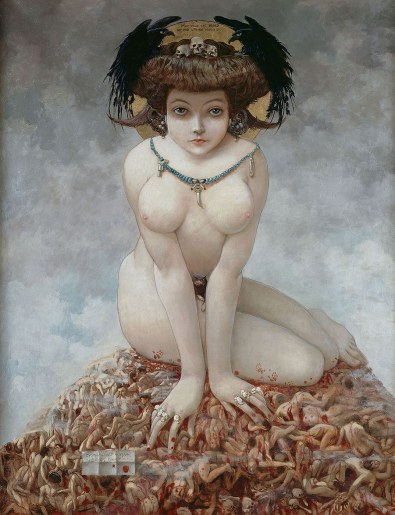
At first glance, the woman with her pretty face looks rather harmless. However, on closer inspection, we notice that she is standing on top of a pile of bloody bodies. With her head crowned with crows and skulls, she looks utterly vicious.
French painter and illustrator Gustav-Adolf Mossa is today considered as the last French Symbolism painter. At the end of the 19th century, Symbolism evolved into a decadent esthetic. It is characteristic of Mossa’s art. Classic literature also inspired his work. He used classical characters to depict issues of his time, the Belle Époque. Women are ubiquitous in Mossa’s work. He portrayed them as femmes fatales, angelic and evil at the same time.
In this painting, Mossa portrayed a courtesan. She stood for the ultimate venal woman, bewitching and controlling men who came seeking her services. Mossa meticulously depicted every detail of this cruel woman and her surroundings. She is only wearing jewels and looking right at the viewer, standing on top of the miniaturized bodies of the men she tortured and killed.
7. The Nightmare, by Henry Fuseli, 1781
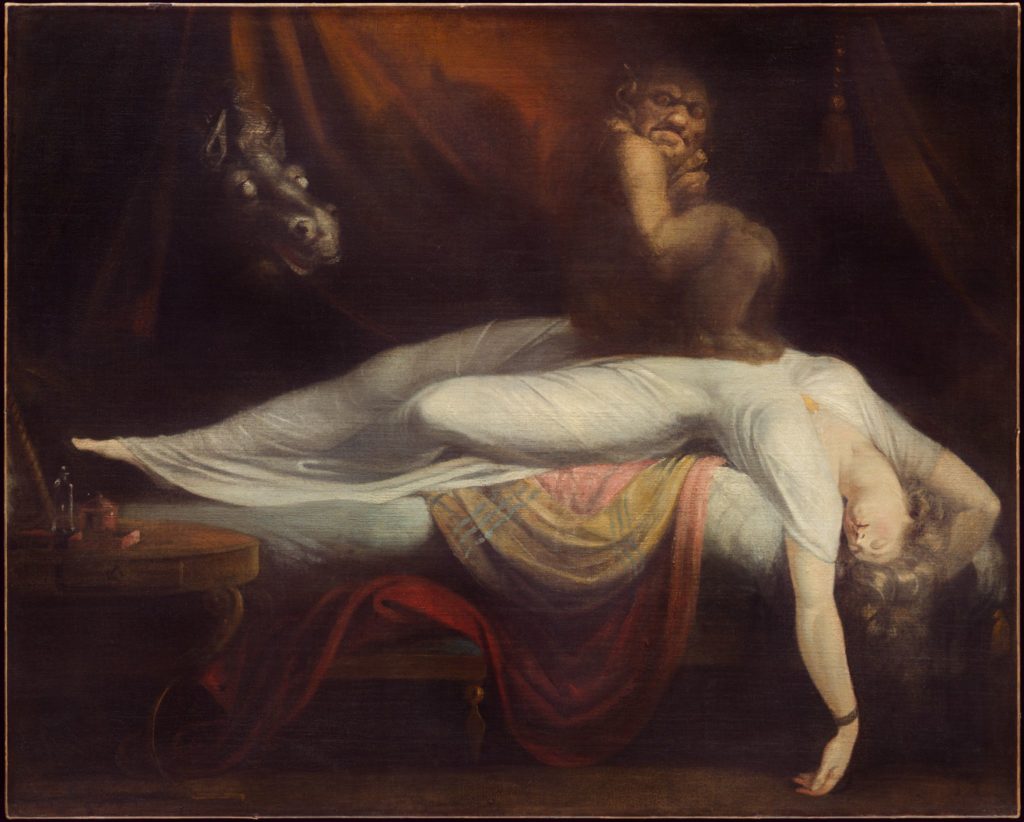
The Nightmare by the Swiss painter Henry Fuseli offers a disturbing sight to the viewer. He depicted sleep paralysis, a state that can happen to anyone. When a person falls asleep or wakes up, a disturbing phenomenon of paralysis while conscious may occur, it provokes a feeling of helplessness and terror in the victim’s mind, as he can neither move nor speak.
In Fuseli’s imagination, sleep paralysis appears as monsters taking over a helpless woman. A demon stands on her chest while a spectral horse head appears behind a curtain. This element comes from a literal interpretation of the term “nightmare,” the mare of the night. Some people see in this painting the premises of Sigmund Freud’s theories. In the 1920s, Freud even had a copy of Fuseli’s painting on his apartment’s wall.
8. Elderly Couple with a Young Female Spirit, by William Hope, ca. 1920
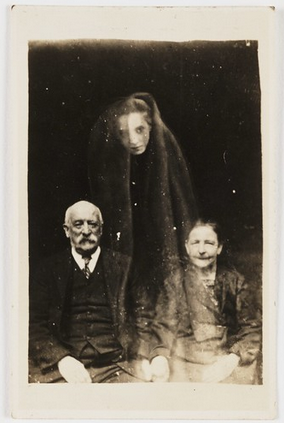
Along with the growing popularity of spiritualism and the development of photography, the late 19th century saw the emergence of a strange form of art: spirit photography or ghost photography. Ghosts started to appear in photographs while people were posing, disturbing their final appearance.
Violent wars marked the 19th century in the Western world. Death was part of life and, in their grief, families hung on to every reminder of their lost loved ones. During the 1850s, photographers discovered a way to capture ghosts. The first spirit photographs were created by accident. As taking pictures required a long exposure, people or objects moving in front of the lens left a transparent shape on the picture. Later, they used double exposure to insert “ghosts” in photographs.
The business of spirit photography rapidly boomed. English photographer William Hope followed the trend and became famous for his double-exposure spirit photographs. He took pictures with the “spirit” of his clients’ dead loved ones. His photographs fooled several celebrities, including Sir Arthur Conan Doyle, the father of Sherlock Holmes.
9. Lucifer, by Franz von Stuck, 1891
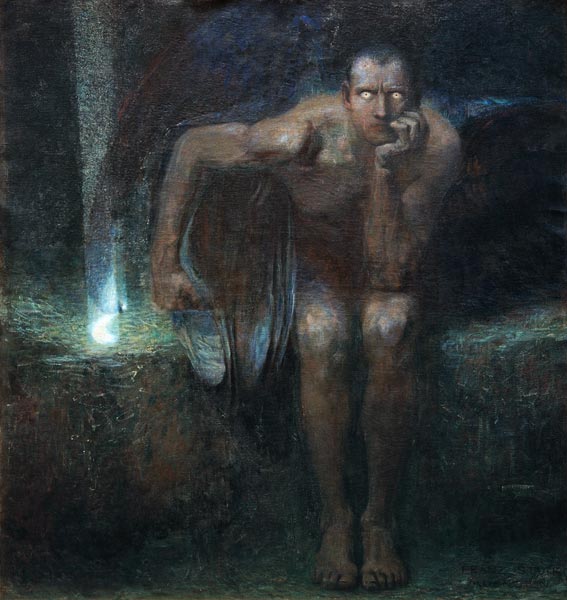
Associated with Venus and the Morning Star in Roman mythology, Lucifer was known as the Light-Bringer. Only when assimilated into the Christian tradition, he became an evil being. First, a fallen angel rebelling against God, Lucifer later embodied the devil.
The nightmarish depiction of Lucifer by German painter Franz von Stuck certainly has the ability to disturb the public. With his dark features and piercing clear eyes, Lucifer looks straight into the viewer’s eyes. He has a strange posture, almost ready to jump. A slight ray of light is the only reminder of Lucifer’s past status as a light-bringer.
Franz von Stuck is a founding member of the Munich Secession and is mainly known for painting mythological and allegorical subjects. He was especially fascinated by evil beings, using a dark color palette to depict them. Von Stuck’s painting joined the royal art collection of Ferdinand I of Bulgaria less than a year after its creation. At least one man was not too scared to acquire the devil’s portrait.
10. The Ballad of Lenore, or The Dead Travel Fast, by Horace Vernet, 1839
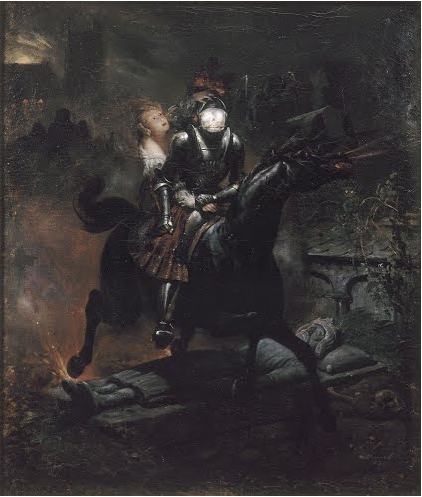
In this painting, French painter Horace Vernet was inspired by the Gothic ballad Lenore, written in 1773 by German poet Gottfried August Bürger. Bürger’s ballad significantly contributed to the booming of vampire literature.
A fervent supporter of Napoleon Bonaparte, Vernet was best known for his military or orientalist paintings. Instead, The Ballad of Lenore shows a strong connection with Romanticism. Vernet depicted the tale of Lenore, a young woman desperately awaiting the return of her lover, William. A soldier in the army of King Frederick II of Prussia, William never came back after the end of the Seven Years’ War. Sorrowful, Lenore blamed God for her misfortunes and expressed her blasphemous thoughts to her mother.
Following her wrongdoing, Lenore was tricked into accompanying a stranger who she thought was William. The stranger invited her for a ride on his horse, and Lenore happily joined him. The horse’s acceleration scared Lenore. While heading to the cemetery, the stranger turned into a terrifying skeleton. Death himself took Lenore to her grave, where she joined the corpse of her dead lover, William. This scary story illustrates the triumph of death over love, quite a gloomy prospect!
